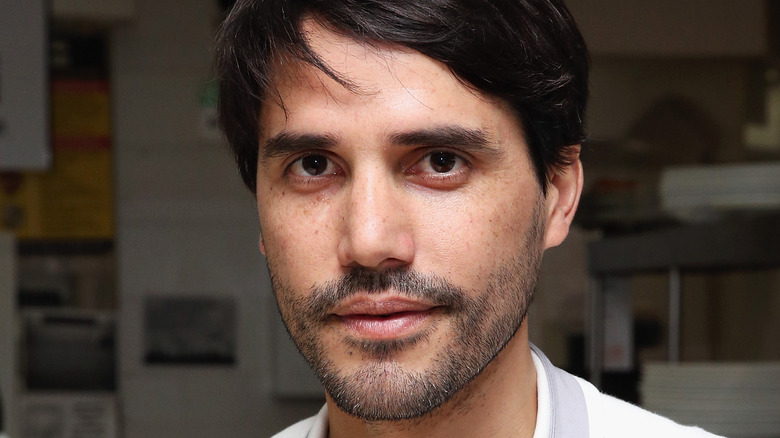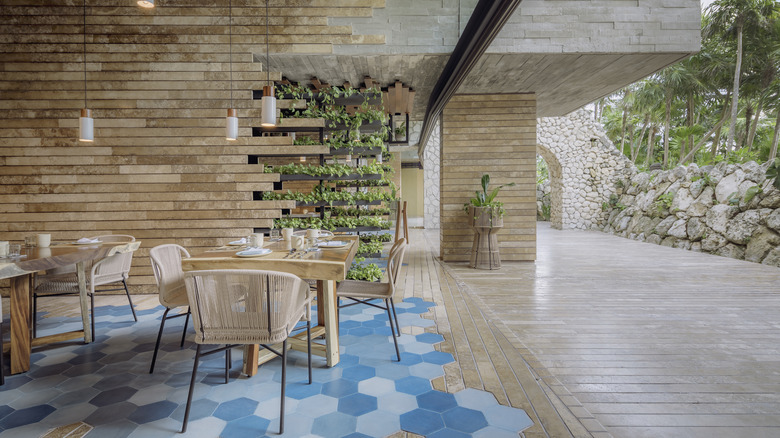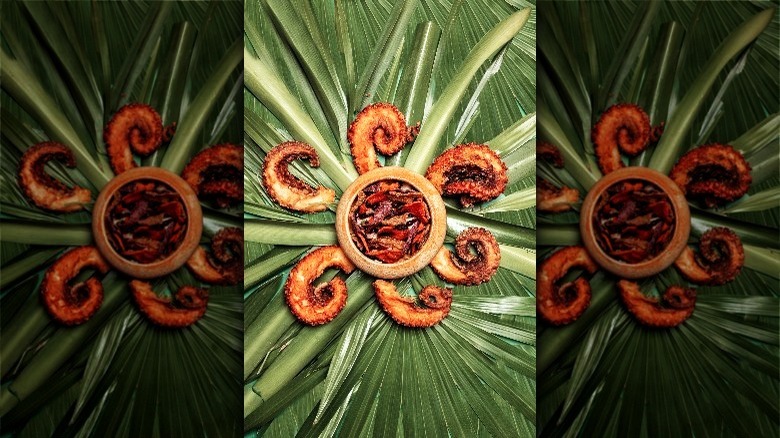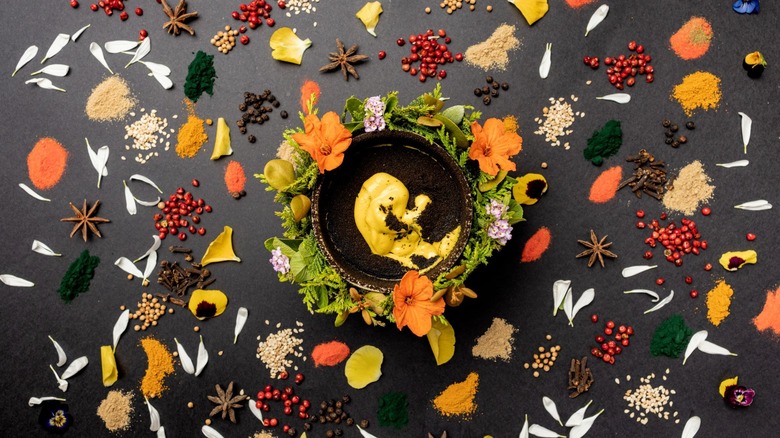How Virgilio Martínez's New Restaurant Connects Mexican And Peruvian Cuisine
It's not often that a culinary artist the caliber of chef Virgilio Martínez opens a new restaurant. Martínez's Lima-based flagship, Central, burst into the culinary consciousness for a simultaneously grounding and devotional approach to the biomes of Peru. For so many, the chef is now regarded as the face of the Peruvian restaurant scene. However, in recent years, Martínez has begun branching out — first, by evolving his signature ethos and then from his native country. Wherever Martínez travels, his deep respect for gastronomy and the earth follows: from Mil Centro, placed high in the Andes, to his Tokyo, Japan, concept, Maz. Now, he's begun again. Chef Virgilio Martínez's newest restaurant, Estero, is located in Mexico's Yucatan Peninsula. It's a fresh theory, but for Martínez it's also a project grown from tradition.
In the age of fusion-everything and trends like chaos cooking, some might mistake the spirits of Mexican and Peruvian cuisines as identical. It's true that even Martínez sees connections between them, yet to him, the distinction is clear. For a chef whose restaurant is currently named number one in Latin America by The World's 50 Best, Martínez's vision for Estero, and the building of a relationship between two national cuisines, is nothing short of unifying.
Speaking to Tasting Table, Martínez shared, "What we are seeing is there's a whole bridge that we're making from South America to Central America, North America. So it's just not about Peru and Mexico."
Estero takes cues from the landscape
Nestled in the Riviera Maya is a small boutique hotel named La Casa de la Playa. Here, diners can have an immersive experience of Mexican and Peruvian cuisines at Estero. Opening a restaurant in a house on the beach spoke to Martínez, both in terms of comfort and creativity. "In my case, the proposal was to have a restaurant that will be a gastronomic experience," he explained. "It's something that really changed the way that I do things because I have to be very open-minded to understand that we are in another location."
The restaurant's design succeeds at bringing together simple, natural elements. Azure floor tiles break like waves on beach-toned wood, while flashes of green life collide with gray concrete. Everything is open to natural light and fresh air, rejoining the interior restaurant with the tropical biome.
"I feel very comfortable here because here I get the feeling that we are in the place," Martínez explained. "We are at the beach. We are in front of the ocean. Why not take advantage of this ecosystem, which is very ... this whole area is very rich."
Exploring the environment is crucial to Martínez, a belief that transcends the differences between Mexican and Peruvian cuisine and piques the chef's deep curiosity into probing the surroundings. "I think we haven't experienced ... how deep is the ocean? The sea here, how rich is the sea?" The answers that emerge from that inquiry chart a new culinary path.
Inspired by Mexican culture
Travel has been a teacher for Martínez, but he set his sights first on highlighting his national cuisine. As his vision for Central fell into place, Martínez began to examine the culinary world beyond Peru. "I started to look for more Latin American flavors," he told us. "It was about more South American inspiration, but then of course I noticed that Mexico has a lot to say to the world in terms of food. So I started to travel to Mexico quite a lot."
Mexico began to inspire Martínez. "When I speak up about Mexico, there are a lot of things that inspire me: Mexican landscapes, Mexican arts, Mexican design, and Mexican traditions," he shared. It was that last component, Mexican traditions — especially those related to food — that created a shift in how Martínez approached Estero and the relationship between cuisines.
"I get to see here more into traditions," he said. "Here there's a lot of respect about the recipe, the sauce, the moles. Let's say mole, the whole mole is a concept that flies, and that really inspired me to follow some recipe that they've been working [on] for years. And this is something that I don't do much in Peru."
Challenging preconceived notions
In a highly commercialized industry, dining establishments that bill as South, Latin, or Central American don't always approach individual cuisines with the differences, apparent or nuanced, that are inherent — nor do those that do, do so clearly. "It's difficult to say now what's inside a Latin American restaurant because people have another idea of what a Latin restaurant is — this typical restaurant where you serve a ceviche with a taco and then you are listening to some salsa," Martínez told us. "And I think the idea is to change this."
Mexican and Peruvian foods have intersections, but like all national cuisines, each has a distinguishable soul. The way ingredients are harvested and harnessed, the techniques employed when cooking, everything results in unique customs and traditions. Take Peruvian and Mexican ceviche. Without knowing the difference in components, marination, the expected expression, you might think that ceviche is ceviche, no matter where you try it. Likewise, El Restaurante explains if not for Spanish colonization, the potato — a staple ingredient of Peruvian cuisine — may never have found widespread cultivation in Mexico.
If there's one core element that the two share, Martínez says it's their diversity. "What I see is that Mexican food, there's not only one Mexican food, there are many Mexican foods: from the south, from the center, from the north," he said. "When I say there's no one Mexican cuisine, there's not even one Peruvian cuisine."
Blending Peruvian and Mexican gastronomy
In chef Virgilio Martínez's opinion, Mexican and Peruvian cuisines have long occupied rival positions. "Mexico has a lot to say, and I think is in a way competing from Lima to Mexico City," he shared. "I get to see this in my restaurant. People ask a lot, 'What's the best destination in Latin America? Is it Lima, is it Mexico?'"
But Martínez sees a collaborative path. "For me, it is both," he said. "We shouldn't be competing as we've competed. We've competed before because people can either go to Mexico City and to Lima for food and now that people are traveling for food, it's not like 20 years ago."
When it comes to that global culinary exploration, at Estero, the travel time between the two countries shrinks. "We do a menu which probably will last two hours where you get to see lots of Mexican ingredients with some Peruvian preparations, also some South American ingredients with some Mexican flavors," Martínez said.
The menu and flavors are a testament to this approach — regional, traditional ingredients married with modern methods. There is shrimp paired with indigenous red corn, mussels dressed in gowns of sargassum algae, tuna crowned in insect caviar. Then, there are components that reveal the broader view, like mango paired with Andean mint. Cultivated by one of the greatest culinary minds of this age, the combination of Mexican and Peruvian cuisines at Estero makes a simple sort of sense, just as the natural world does when we take the time to observe.




